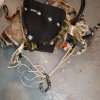MNFarmHunter
Well-Known Member
Having more time to think about what happened, and a full sized keyboard, the issue was a wet, slick tree trunk and single foot climbing. With single foot, you need the friction of your bottom foot against the trunk along with your wrap leg to lock you in. With the slick trunk, I couldn't get a solid grip but still managed to climb 12' before I quit.
This goes back to the double foot loop. It's more efficient and less effort but slower than the single foot so I decided to not use it as my primary method. However, climbing down on that same slick trunk using my double loop was no problem. This has me thinking again about the double loop and accepting the slower climb due to an easier and possible safer climb.
Tomorrow, I'm going to do a double foot climb as high as I can go to test things out.
This goes back to the double foot loop. It's more efficient and less effort but slower than the single foot so I decided to not use it as my primary method. However, climbing down on that same slick trunk using my double loop was no problem. This has me thinking again about the double loop and accepting the slower climb due to an easier and possible safer climb.
Tomorrow, I'm going to do a double foot climb as high as I can go to test things out.
Last edited:









